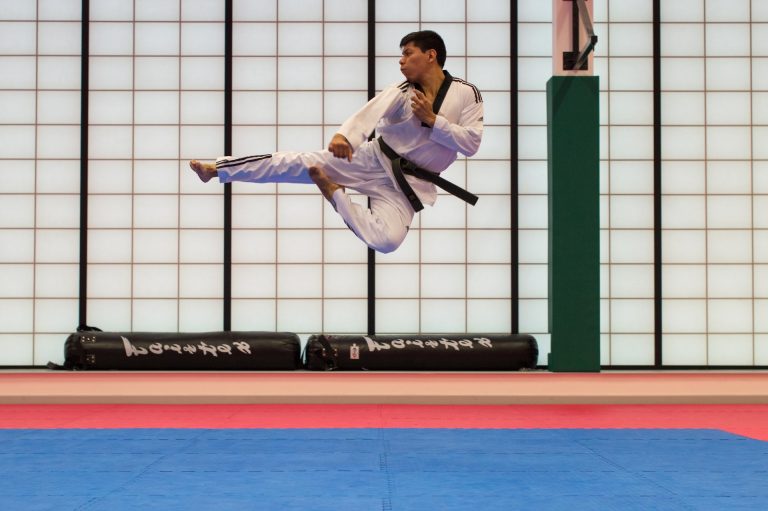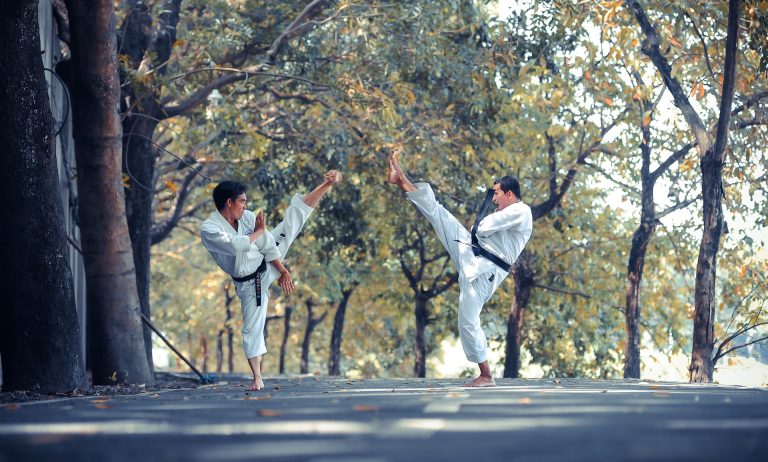How Does Karate Grading Work?
Karate is a martial art that has gained popularity all over the world, and it involves a combination of various techniques, including punches, kicks, and strikes. The primary focus of karate is to develop an individual’s physical strength, discipline, and character. To recognize the progress of karate students, the art has established a grading system that assigns belts of different colours to the students based on their level of mastery. In this blog post, we take a closer look at how the karate grading process works.
The Karate Grading System
The karate grading system comprises a series of levels that are assigned to students based on their ability and proficiency in the art. Typically, these levels start with a beginner’s level and progress to advanced levels for more experienced practitioners.
The period between each level can range from a few months to several years, depending on the individual’s dedication and skill level. The system comprises four main categories: kyu (colored belts), dan (black belts), and advanced levels (higher dan), and teaching levels.
Kyu Level (Colored Belts)
The kyu system comprises ten levels, starting from white belt and ending with brown belt, with each color indicating different levels of proficiency. Below are the different kyu levels and their corresponding belt colors, ordered from beginner to more experienced ranks:
– White Belt: This is the starting rank for all beginners, indicating zero or little knowledge of karate. At this level, beginners learn basic movements and techniques, such as punches, kicks, and strikes, and must demonstrate the ability to perform them effectively.
– Yellow Belt: After completing the initial stages of training, students can progress to the yellow belt. At this stage, beginners must show that they have learned basic techniques and movements, while demonstrating accuracy and control.
– Orange Belt: At this stage, students are required to demonstrate more advanced techniques and movements, such as blocks and strikes.
– Green Belt: Students who have reached the green belt level are required to demonstrate high levels of proficiency and expertise, including more complex combinations of movements and techniques.
– Blue Belt: At this level, students must show proficiency in their understanding of the basic concepts of karate, including awareness, application, and control.
– Purple Belt: Purple belt students are expected to demonstrate mastery of the concepts of karate and the ability to execute various techniques effectively.
– Brown Belt: Students at this level are required to show exceptional skill and knowledge in karate, such as advanced techniques and principles of form and strength.
– Brown 2nd Kyu: This is the intermediate stage of knowledge, where students polish themselves as black belt aspirants with advanced techniques.
– Brown 1st Kyu: This is an advanced level of training, and students must demonstrate expertise and mastery in all areas of karate.
Dan Level (Black Belts)
After achieving the brown 1st kyu level, students can then progress onto the dan level, which is represented by the black belt. In the dan system, there are ten degrees of black belts, each denoting different levels of proficiency. The first-degree black belt (Shodan) is the initial stage of black belt mastery, while the fifth-degree black belt (Godan) represents the highest level of proficiency reached through practice and dedication.
The dan levels are divided into three categories, including advanced levels (fourth and fifth-degree black belts), higher dan (sixth to ninth-degree black belts), and teaching levels (tenth-degree black belt).
Examining the Grading Process
The process of grading students in karate is rigorous and structured, involving three primary components- the technical component, educational component, and physical examination.
During the examination, assessors evaluate the students‘ understanding and mastery of different techniques and movements, including control, focus, power, stance, and posture. Assessors also evaluate the students‘ understanding and application of karate principles, including awareness, control, and timing.
The educational component involves evaluating the students‘ understanding of the philosophy of karate, including character development, history, and ethics. Students must demonstrate their knowledge of these principles to advance to higher levels.
Lastly, the physical examination involves testing the students‘ physical fitness and endurance levels, including speed, strength, and stamina. Students must show that they can maintain peak physical performance during testing.
What is karate grading?
Karate grading is a system that is used to rank karate practitioners based on their skill level. The ranking system in karate is designed to provide a structured way for practitioners to measure their progress as they continue to develop their skills.
How does karate grading work?
The karate grading system is represented by colored belts, and each belt color signifies a different skill level. The belt colors used in karate are, in ascending order of skill level: white, yellow, orange, green, blue, brown and black. The white belt signifies the beginner level and black belt represents the level of mastery.
Each martial arts organization sets its own criteria for the specific skills, knowledge, and physical fitness required of each level of the grading system for each belt color.
What are the requirements for passing a karate grading test?
The requirements for passing a karate grading test vary depending on the martial arts organization and the level being tested. However, in general, candidates for a karate grading test will be evaluated on their mastery of basic techniques, mental and physical fitness and their understanding of karate principles and philosophy.
Some specific requirements for passing a karate grading test may include:
- Performing a set sequence or kata of techniques
- Sparring with an opponent or opponents
- Demonstrating their understanding of karate principles and philosophy
- Breaking boards or other objects with their hands or feet to demonstrate strength and accuracy
- Showing strength, flexibility and endurance through various physical tests
How long does it take to advance through the karate grading system?
The amount of time it takes to advance through the karate grading system depends on a number of factors, including the martial arts organization, the individual’s natural ability, and the time and effort the student is willing to dedicate to training.
Generally, it takes several years to advance to higher belt ranks, with students typically eligible for promotion after a certain amount of time has passed and certain skills have been demonstrated.
What are the benefits of karate grading?
Karate grading serves as a motivation for students to improve their skills and reach their full potential. It also helps students to set goals and track their progress, which is an essential part of any learning process.
Moreover, karate grading helps to ensure that standards are maintained throughout the martial arts community, and that students are learning the appropriate techniques and skills for their level.
How Does Karate Grading Work?
Karate is a popular martial art known for its striking techniques, including kicks, punches, and knee and elbow strikes. One of the key elements of karate is the grading system, which provides students with a way to measure their progress and advance through the ranks. In this article, we will explore how karate grading works, including the different levels, requirements, and examination process.
Karate Grading Structure
Karate grading is typically divided into two main categories: kyu and dan. Kyu is the student ranking system, which ranges from white belt (beginner) to brown belt (advanced). Dan is the master ranking system, which ranges from first dan to tenth dan. The higher the dan, the more advanced and masterful the karateka (karate practitioner).
Kyu Grading System
The kyu grading system is essential for measuring a student’s progress in karate. It consists of ten kyu levels, starting with white belt (10th kyu) and ending with brown belt (1st kyu).
In most karate schools, a student can achieve a new belt by passing an examination that demonstrates their mastery of the required techniques and knowledge. These examinations are typically held at the dojo (karate school) and are overseen by a panel of examiners who are higher-ranked martial artists.
Requirements for Promotion
The requirements for promotion to the next kyu level can vary from school to school. However, some of the most common requirements include:
- Knowledge of the basic techniques and stances of karate
- Ability to perform katas, which are pre-set sequences of movements simulating a fight against multiple opponents
- Discipline and respect for the art and its traditions
- The minimum time required at the current rank, which can range from several months to a year or more.
How to Prepare for Kyu Grading Exam
Preparing for a kyu grading exam requires a lot of dedication, practice, and discipline. Here are some tips to help you prepare for your next grading:
- Attend regular classes and practice daily to build your skills and confidence
- Seek feedback from your instructor to understand your strengths and weaknesses
- Practice and refine your techniques until they become second nature to you
- Maintain a positive attitude and stay committed to your goals
Dan Grading System
The dan grading system is reserved for higher-level karateka who have achieved advanced proficiency in the art. The dan grades range from first dan (shodan) to tenth dan (judan), with each level representing a new level of mastery.
Requirements for Promotion
The requirements for dan promotion are much more rigorous and demanding than those for kyu. Students must typically demonstrate their mastery of advanced techniques, including multiple-person katas, weapons training, and advanced fighting strategies. They must also have a deep understanding of karate philosophy, history, and traditions.
How to Prepare for Dan Grading Exam
Preparing for a dan grading exam can take years of dedicated practice and study. Here are some tips to help you prepare for your next dan grading:
- Continue to develop your skills and knowledge by training regularly with experienced instructors
- Train in different styles and schools to gain exposure to different techniques and perspectives
- Attend seminars and workshops to learn from master instructors
- Engage in regular self-reflection to assess your progress and areas for improvement
In Conclusion
Karate grading is an essential element of the art, providing students with a way to measure their progress and advance through the ranks. Whether you are a beginner or an advanced karateka, understanding the grading system’s structure, requirements, and examination process can help you set and achieve your goals. By following these tips and maintaining your commitment to the art and its traditions, you can continue to grow and improve your karate skills over time.
Inhaltsverzeichnis






